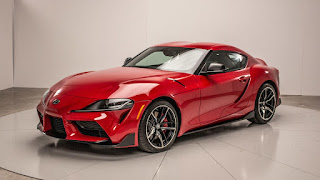You’ve likely heard of engines like the 4-cylinder, V6, V8,
and maybe even a V10 or V12. These engines are commonly found in many Orlando
Toyota vehicles like the Toyota Corolla, Camry, 4Runner, you name it. These engines provide ample power to propel
our vehicles forward or give a sporty feel when you press the gas pedal. While
shopping for a typical Toyota vehicle, you won’t come across many different engines
beyond those above. But, with the return of the Toyota Supra this coming year you’ve
likely heard the term “straight-six engine.” While this engine type isn’t common
for the typical commuter vehicle, straight or inline engines have been used on
several vehicles throughout the ages. Before the new Supra arrives on our lot
at Toyota of Orlando, check out this guide on inline engines and know what you’re
driving.
The inline engine and the legendary Toyota Supra
It’s been some time since Toyota has used an inline engine
in a mass-produced vehicle until the reintroduction of the Orlando Toyota Supra
set to release this year. While they haven’t been used in vehicles in quite some
time, inline engines are very fuel-efficient and create a good balance for
vehicles that use them. But straight engines are larger and require more room in
engine compartments which leads to a more expensive sticker price for a car as
opposed to one with a more comparable V configured engine.
One Orlando Toyota inline engine that’s been especially
legendary was the Toyota 2JZ – GTE engine that was built into the 1991 Toyota
Aristo V first and then the Toyota Supra RZ. This engine was specified to have
280 horsepower stock and then 320 in 1993. But the reason why this engine is
particularly popular among Orlando Toyota drivers is its ability to obtain over
1,000 horsepower without changing many stock components in the engine.
What makes an inline engine unique is the way the cylinders are aligned. Rather than using a V configuration like many common Orlando Toyota
engines, straight engines align their cylinder in a straight line and can be
positioned in nearly any orientation in the engine compartment and even be
slanted. These engines are inherently balanced and smooth whereas horizontally
opposed engines, while more compact and compatible with modern car designs, are
largely unbalanced and somewhat less efficient. While the 2020 Toyota Supra comes equipped with a straight six engine, there are also straight four, straight eight, and even straight five engines that have been used on a variety of vehicles.
Where the modern Toyota Supra comes in
The 2020 Orlando Toyota Supra is set to be released this
year and is being engineered with a straight six inline engine to hold true to
the origins of the iconic sports car many drivers love. While it won’t match
the aftermarket compatibility and capability of the 2JZ – GTE engine, it still
packs a powerful 335 horsepower and maintains a 0-60 mph time of 4.1 seconds.
The new Toyota Supra will be available in trim levels such as the 3.0, 3.0
Premium, and limited Launch Edition.
If you have more questions on how inline engines work or the
new 2020 Toyota Supra, come visit Toyota of Orlando today! We’re located at 3575
Vineland Road and open seven days a week.



No comments:
Post a Comment
Note: Only a member of this blog may post a comment.